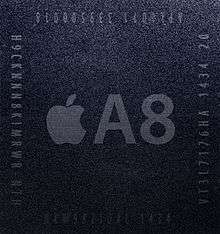Apple A8
 Apple A8 processor | |
| Produced | From September 9, 2014 to Present |
|---|---|
| Designed by | Apple Inc. |
| Common manufacturer(s) | |
| Max. CPU clock rate | 1.1 GHz (iPod Touch 6th generation) to 1.4 GHz (iPhone 6, iPhone 6 Plus) and 1.5 GHz (iPad mini 4 & Apple TV (4th Gen))[2] |
| Min. feature size | 20 nm[3] |
| Instruction set | A64, A32, T32 |
| Microarchitecture | Typhoon[4][5] ARMv8-A-compatible[6] |
| Product code | APL1011[7] |
| Cores | 2[8] |
| L1 cache | Per core: 64 KB instruction + 64 KB data[6] |
| L2 cache | 1 MB shared[6] |
| L3 cache | 4 MB[6] |
| Predecessor | Apple A7 |
| Successor | Apple A9 |
| GPU | PowerVR Series 6XT GX6450 (quad-core)[9] |
| Application | Mobile |
| Variant | Apple A8X |
The Apple A8 is a 64-bit ARM based system on a chip (SoC) designed by Apple Inc. It first appeared in the iPhone 6 and iPhone 6 Plus, which were introduced on September 9, 2014.[10] Apple states that it has 25% more CPU performance and 50% more graphics performance while drawing only 50% of the power compared to its predecessor, the Apple A7.[11]
Design
The A8 is manufactured on a 20 nm process[3] by TSMC,[1] which replaced Samsung as the manufacturer of Apple's mobile device processors. It contains 2 billion transistors. Despite having twice the number of transistors compared to the A7, the A8's physical size has been reduced by 13% to 89 mm2.[8] The A8 in the iPhone 6 and 6 Plus has 1 GB of LPDDR3 RAM included in the package,[7] while the A8 in the iPad Mini 4 and 4th generation Apple TV is packaged with 2 GB of LPDDR3 RAM.[12][13]
The A8 has a per-core L1 cache of 64 KB for data and 64 KB for instructions, a L2 cache of 1 MB shared by both CPU cores, and a 4 MB L3 cache that services the entire SoC.[6]
Benchmarks suggest that the processor is dual core, and as used in the iPhone 6 has a frequency of 1.38 GHz, supporting Apple's claim of it being 25% faster than the A7.[14] It also supports the notion of this being a second generation[15] enhanced Cyclone core called Typhoon,[4][5] and not an entirely new architecture which would supposedly mean a more significant performance gain per Hz.[6]
The A8 also integrates a graphics processing unit (GPU) which AnandTech believes to be a 4-cluster PowerVR GX6450.[16]
On October 16, 2014, Apple introduced a variant of the A8, the A8X, in the iPad Air 2. Compared to the A8, the A8X has improved graphics and CPU performance due to one extra core and higher frequency.
Patent litigation
On October 14, 2015, a district judge found Apple guilty of infringing U.S. patent US 5781752, "Table based data speculation circuit for parallel processing computer", on the Apple A8 and A7 processors. The patent is owned by Wisconsin Alumni Research Foundation, a firm affiliated with the University of Wisconsin. The company could be liable for up to US$862.4 million in damages.[17]
Products that include the Apple A8
See also
- Apple mobile application processors, the range of ARM-based mobile processors designed by Apple for their consumer electronic devices.
- Comparison of ARMv8-A cores
- Apple A8X
Notes
References
http://www.applenewsblog.org/iphone-6-specifications/
- 1 2 3 "Inside the iPhone 6 and iPhone 6 Plus". Chipworks. September 19, 2014. Archived from the original on 2014-09-24. Retrieved September 20, 2014.
- ↑ "iPad Mini 4 performance preview: A 1.5GHz Apple A8 with 2GB of RAM". Ars Technica. September 15, 2015. Retrieved September 16, 2015.
- 1 2 Smith, Ryan (September 9, 2014). "Apple Announces A8 SoC". AnandTech. Retrieved September 9, 2014.
- 1 2 The Samsung Exynos 7420 Deep Dive - Inside A Modern 14nm SoC
- 1 2 Chester, Brandon (July 15, 2015). "Apple Refreshes The iPod Touch With A8 SoC And New Cameras". Retrieved September 11, 2015.
- 1 2 3 4 5 6 "The iPhone 6 Review: A8's CPU: What Comes After Cyclone?". AnandTech. September 30, 2014. Retrieved September 30, 2014.
- 1 2 "iPhone 6 Plus Teardown". iFixit. September 18, 2014. Retrieved September 19, 2014.
- 1 2 Anthony, Sebastian. "Apple's A8 SoC analyzed: The iPhone 6 chip is a 2-billion-transistor 20nm monster". www.extremetech.com. ExtremeTech. Retrieved 10 September 2014.
- ↑ Smith, Ryan (September 23, 2014). "Chipworks Disassembles Apple's A8 SoC: GX6450, 4MB L3 Cache & More". AnandTech. Retrieved September 23, 2014.
- ↑ "Apple Announces iPhone 6 & iPhone 6 Plus—The Biggest Advancements in iPhone History" (Press release). Apple. September 9, 2014. Retrieved September 9, 2014.
- ↑ Savov, Vlad (September 9, 2014). "iPhone 6 and iPhone 6 Plus have a new faster A8 processor". The Verge. Vox Media. Retrieved September 9, 2014.
- ↑ Chester, Brandon (September 9, 2015). "Apple Announces the iPad Pro and iPad Mini 4". AnandTech. Retrieved September 9, 2015.
- ↑ "The New Apple TV". Apple Inc. September 9, 2015. Retrieved September 9, 2015.
- ↑ Alleged iPhone 6 Geekbench Results Reveal 1.4 GHz Dual-Core A8 Chip, 1 GB of RAM
- ↑ Apple - iPhone 6 - Technology
- ↑ "The iPhone 6 Review: A8's GPU: Imagination Technologies' PowerVR GX6450". AnandTech. September 30, 2014. Retrieved September 30, 2014.
- ↑ "Apple faces $862M patent damage claim from University of Wisconsin". Ars Technica.
- ↑ "Logic Detailed Structural Analysis of the 20 nm Node, TSMC Fabricated Apple A8 APL1011". Techinsights. August 28, 2015. Retrieved December 3, 2015.
- ↑ Ho, Joshua (November 2, 2015). "The Apple iPhone 6s and iPhone 6s Plus Review: Analyzing Apple A9's SoC". AnandTech. Retrieved December 3, 2015.
- ↑ Hesseldahl, Arik (September 23, 2014). "Teardown Shows Apple's iPhone 6 Cost at Least $200 to Build". Re/code. Retrieved December 1, 2015.
